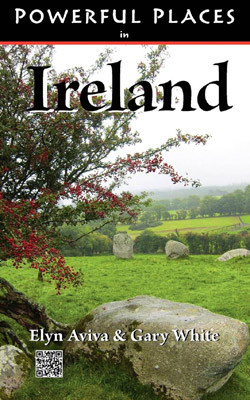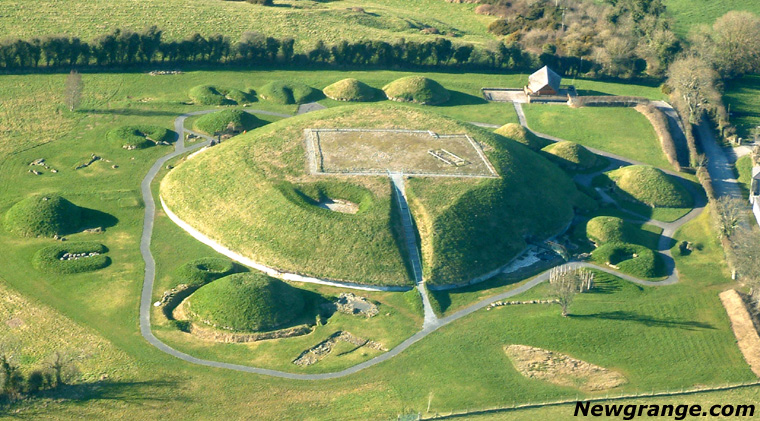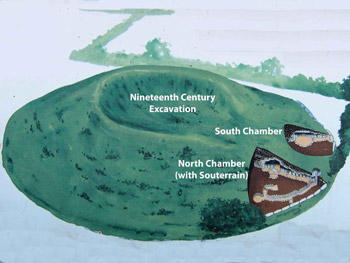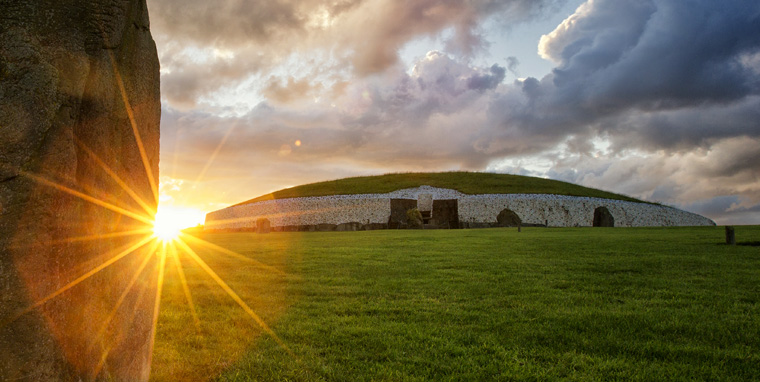
Powerful Places in Ireland
Powerful Places in Ireland by Elyn Aviva & Gary White is not your usual guidebook. It is not about visiting places, it's about experiencing them. Ireland is a magical place, bright and shining, misty and mysterious, filled with powerful sites. You could say, most of Ireland is a powerful place. Come and explore a carefully chosen selection of Ireland's impressive megalithic sites, including grass-covered cairns and massive stone circles; holy wells and sacred mountains; ruined abbeys and medieval chapels.
Powerful Places in Ireland provides detailed descriptions of these powerful places, including how to get there and what to do when you arrive. Numerous maps, graphics, and photos bring the locations to life. GPS headers are included to help you locate sites that are difficult to find, as well as QR codes for ease of accessing relevant websites. If you are intrigued by the unusual; if you long to connect more deeply with the places you visit; if you have a nagging feeling that there's more to some places than meets the eye, this is the travel guide for you.
Purchase at Amazon.com or Amazon.co.uk
Boyne Valley Powerful Places included in the book: Newgrange, Knowth, Dowth, Lady Well at Slane Castle, Hill of Slane, Hill of Tara, Monasterboice, Rathmore Church, Balgeeth Sheela-na-gig, Fourknocks, Loughcrew (Sliabh na Cailli), Tlachtga, Hill of Ward and St Ciaran's Well
Excerpt from Powerful Places in Ireland:
Newgrange, Knowth, and Dowth are huge man-made mounds located close together in the Boyne Valley (Brú na Bóinne), near a great loop of the river Boyne. Within each mound are carefully constructed stone passage graves; they also served as ceremonial venues. The mounds are the best-known archeological complex in Ireland and a UNESCO World Heritage Site. The site also includes a number of smaller mounds, henges, and standing stones.Brú na Bóinne's fertile soil supported Neolithic farmers beginning around 3800 BCE. By about 3300 BCE, 700 years before the Egyptian pyramids and 1000 years before Stonehenge these farmers began constructing megalithic monuments. They had sophisticated expertise in engineering, geology, art, and astronomy, which they put to use in their constructions.
Newgrange, Knowth, and Dowth are each set in their own ritual landscape, which includes other megaliths. From the top of Dowth you can see Newgrange and, if you could stand on top of Newgrange, you could see Dowth. Knowth is visible from the back of Newgrange as well. Three or possibly more satellite tombs stretch from Newgrange towards nearby Dowth.
Although we don't know what this meant to the megalith builders, we can assume that this intervisibility was important.
These huge man-made mounds are constructed from alternating layers of earth and stone, with carefully engineered interior stone passages that end in chambers. Large kerbstones, laid end to end, surround and stabilize the mounds. Many of them are elaborately carved. At its height as a ceremonial center and cemetery complex, there may have been as many as 700 decorated stones in Brú na Bóinne.
The only way to visit Newgrange and Knowth is by an OPW (Office of Public Works) guided tour from Brú na Bóinne Visitor Center, located on the south side of the Boyne River near Donore. Dowth is directly accessible to visitors who walk or drive to the site.
Newgrange
High on a ridge in the middle of the Boyne Valley, Newgrange is the best known of the three mounds. Its unique triple-spiral kerbstone is emblematic of Irish megalithic art. Newgrange was probably constructed around 3200 BCE and continued to be the focus of religious activity into the late Neolithic and early Bronze Age. At one point, it was thought (or imagined) to be the burial mound of the legendary kings of Tara. Romano-British votive objects were buried there between the first and fourth centuries CE, indicating its ongoing importance as a ritual center.The squashed-oval diameter of the surrounding kerb varies from 79 m (260 ft) northwest-southeast and 85 m (280 ft) northeast-southwest, though these figures depend on who is holding the tape measure. It is 11 m (36 ft) high. A partial circle of standing stones surrounds it. Newgrange has one interior passage tomb, which ends in a cruciform, a shape that also resembles the human body with outstretched arms. Large, chiseled basins that once held cremated remains are located on the floor in each of the three side recesses.
Newgrange's reconstructed facade of quartz interspersed with egg-shaped granite stones may or may not be accurate but it is impressive. One can imagine the sunlight glinting off the white surface, making it shine like a beacon. It is interesting and probably important that the glittering quartz remains cool to the touch, while the darker granite absorbs the sun's rays. Newgrange is awesome today; it must have been even more compelling 5000 years ago, when it was the site of ceremonies and ritual.
The OPW guided tour permits you to enter the 19 m (62 ft) long passage for a short time and admire the elaborate carvings on the upright stones. On a clear morning around the winter solstice, sunlight streams through a roof-box opening above the entrance and penetrates the passage, coming to rest on the back wall of the rear chamber. Or at least it used to. Subtle shifts in the position of the earth and sun now cause the light to fall a little short of its intended target. A triple-spiral design is carved into the side wall of the rear recess, and it is possible that the morning sunlight was reflected (by a polished stone?) onto the triple spiral. An annual lottery provides access to the interior for the winter solstice sunrise around 21 December.
Although Newgrange is called a passage tomb, presumably because bone and cremains (cremated remains) were found inside the chambers, it is obvious that it was not just a place of burial. It was used for cyclical ceremonies of great importance. Some writers speculate that Newgrange was used for rituals related to childbirth or fertility. Perhaps the numerous stone balls, phallic-shaped objects, and large basins found in the chambers relate to this.
A huge body of mythology swirls around Newgrange. One story tells how the Dagda (father god of the Túatha Dé Danann) mated with the great goddess Bóinne, who lived at Brú na Bóinne. Nine months later (magically time had stopped, so it only seemed like a day), she gave birth to a son, Aenghus Og (Aenghus the Young). Perhaps the winter solstice light penetrating deep into the passage was a visual representation of this mythic union.
A later legend describes Newgrange as the "Fairy Dwelling" where the great Irish hero Cúchulainn was born. The god Lugh (the Shining One) "visited" his mother, Dechtire, on her wedding night, after which she was informed she would bear his child. She retired to Brú na Bóinne and, nine months later, gave birth to Cuchulainn.
Newgrange has continued to have a powerful hold on the mythic imagination for millennia, and it continues to be a powerful place, drawing thousands of visitors throughout the year who bring a mixture of curiosity, awe, and reverence.
Although it is impossible to experience the site as it once was, especially on an OPW guided tour, consciously center yourself and be present (see pp. 00). Walk around the outside in a circular direction, following the line of the standing stones. When it is your group's turn to enter the mound, you will cross behind the triple-spiral kerbstone and over the threshold into the narrow, dark passageway. What do you feel? Is it like entering a cave? A birth canal? Notice the carvings along the way. What do they evoke in you? And then, as the passage opens into the main chamber, how do you experience this expansion? Your guide will use lighting to recreate the winter solstice sunrise light entering the darkness and illuminating the passageway. What do you experience?
Knowth
Located about a kilometer (0.6 mi) away on a bluff high above the Boyne, Knowth is larger and older than Newgrange. It lacks Newgrange's awesome quartz-fronted facade, and visitors are not permitted inside the main passage tomb, but it has other attractions. Archeological evidence indicates it was first a settlement, but by 3300 BCE construction was begun on what would become one main mound with two passage tombs, opening to the east and west, roughly in line with the equinox sunrises and sunsets, and eighteen satellite tombs. Today, the grass-covered cairns, surrounded by kerbstones, resemble a field of enormous green mushrooms.The main mound at Knowth is the biggest in Brú na Bóinne. It is 85 m (279 ft) in diameter, nearly 10 m (33 ft) high, and includes over 300 decorated stones making it the largest collection of rock art at a single site in Europe. It has a kerb of 127 contiguous stones, many of them ornately carved with motifs whose meaning has yet to be deciphered.

Aerial view of the Knowth site | Large mound (known as Knowth Site 1) and 18 smaller satellite mounds
Knowth was utilized from Neolithic times until about 1400 CE. At some point it was turned into a fortification, and in the 800s it was the seat of the kings of northern Brega. They knew a powerful place when they found it, even if by then the entrances into the mound had been long forgotten. At the end of the twelfth century, the Normans used the mound as a motte.
The OPW guided visit to the site explains in detail its transformation over the centuries. Although you can't enter the passage graves, Knowth is an impressive, though heavily reconstructed, site.
Getting There
To visit Newgrange and Knowth you must go to the Brú na Bóinne Visitor Center. Entrance is only from the Visitor Center, and a strictly limited number of tickets are available daily for specific time slots. You buy your tickets, then cross the footbridge over the river to the north side at the appointed time. You then get on a shuttle bus that takes you to one or the other monument.Go early in summer to avoid long queues. Allow three hours minimum for the visit to both Knowth and Newgrange. The Visitor Center has excellent exhibits and a well-stocked bookstore, as well as a reconstruction of the entrance and interior of Newgrange.
It can be confusing to drive to the Visitor Center. Do not trust your GPS to get it right. The Brú na Bóinne Visitor Center is 2 km (1.2 mi) west of Donore Village on the south side of the River Boyne. The route from the east (M1 and Drogheda) is via Donore. From the west (N2 and Slane) take the turn on the N2 2 km south of Slane signposted Brú na Bóinne (Newgrange). It is advisable to check the latest directions from OPW (Office of Public Works), which is in charge of the Center.
Dowth
Unlike Knowth and Newgrange, a visitor to Dowth does not have to take a guided tour. This means that once you find your way there, you can experience the site at your own rhythm. You can meditate, do ritual, perhaps have a picnic under the huge sycamore tree on the south side of the tumulus. Although it is only a kilometer from Newgrange, Dowth is no longer developed and is not much publicized, so it is rarely visited. Bring a flashlight to help you see into the passages. Park
your car by the gate and walk up the trail past the now-closed ticket shed.
Dowth is just beyond. The grass-covered mound is 85 m (279 ft) in diameter, with
115 kerbstones some of which are still visible. As you walk around, you'll
notice entrances on the west to two interior tombs known as North and South
Dowth. The more northerly has an 8 m (26 ft) long passage that opens into a
cross-shaped chamber with an annex and a corbelled roof. It appears to be
aligned with Samhain (Halloween) sunset and includes impressive megalithic
carvings. A large basin stone (1.4 m by 1 m, approx. 4.5 ft by 3 ft) occupies
most of the floor of the main chamber. At one time, you could enter the passage
by climbing down an iron ladder, but now there is no access. An early medieval
souterrain leads off from the passage, its purpose uncertain. Souterrains may
have been used for storage or concealment of goods, for temporary refuge, or
perhaps for dream incubation and ritual.
Park
your car by the gate and walk up the trail past the now-closed ticket shed.
Dowth is just beyond. The grass-covered mound is 85 m (279 ft) in diameter, with
115 kerbstones some of which are still visible. As you walk around, you'll
notice entrances on the west to two interior tombs known as North and South
Dowth. The more northerly has an 8 m (26 ft) long passage that opens into a
cross-shaped chamber with an annex and a corbelled roof. It appears to be
aligned with Samhain (Halloween) sunset and includes impressive megalithic
carvings. A large basin stone (1.4 m by 1 m, approx. 4.5 ft by 3 ft) occupies
most of the floor of the main chamber. At one time, you could enter the passage
by climbing down an iron ladder, but now there is no access. An early medieval
souterrain leads off from the passage, its purpose uncertain. Souterrains may
have been used for storage or concealment of goods, for temporary refuge, or
perhaps for dream incubation and ritual.
The shorter, more southerly passage leads to a pear-shaped chamber. The winter solstice light that penetrates Newgrange in the morning reaches this passage at sunset. The Gaelic name for Dowth, Dubhadh, means darkness; perhaps it refers to the darkness of the longest night of the year. The light of the setting sun enters the chamber and lights up carvings in a side recess on the right as well as carvings in the main chamber. Note the cup markings in the kerbstone in front; they may represent the path of the setting solstice sun.
If you climb up the mound and the weather conditions are right, you can see Newgrange and Knowth, the Hill of Slane, and Tara. The grass-covered crater at the top is the scar that remains from nineteenth-century treasure hunters or perhaps stone quarrying. On the east side of the mound is a "faery" tree (a lone thorn tree) and a fence, guarding a row of kerbstones with interesting carvings visible if the sunlight (or your flashlight) falls at the right angle. Kerbstone K51 has a series of what look like sun signs, but no one knows what they really mean. There are also two standing stones in the field, and our companions described them as the focus of powerful earth energies. Although the standing stones appear short, the soil surface is now 1 m (3 ft) higher than it used to be.
Archeologist and tour guide Martin Dier showed us around Dowth. His enthusiasm helped us to see not a mound desecrated by quarrying and treasure hunting but a powerful sacro-religious space. According to Martin, part of the delight of Dowth is that it hasn't been reconstructed like Newgrange and Knowth. He told us, "We're seeing Dowth the way it's looked for hundreds of years. We couldn't have that if it was excavated and 'under control.' It's sort of the 'wild sister' of the Boyne Valley."
The grass-covered tumulus with its gated entry is no longer "open for tourists," but that's a good thing. You are free to wander, to imagine what it might have looked like millennia before, and to experience the energies that run strong beneath the land. This power is still palpable: after all, people are still drawn to Dowth to conduct ceremonies, just as they have for more than 5000 years.
Boyne Valley Private Day Tour
 Immerse yourself in the rich heritage and culture of the Boyne Valley with our full-day private tours.
Visit Newgrange World Heritage site, explore the Hill of Slane, where Saint Patrick famously lit the Paschal fire.
Discover the Hill of Tara, the ancient seat of power for the High Kings of Ireland.
Book Now
Immerse yourself in the rich heritage and culture of the Boyne Valley with our full-day private tours.
Visit Newgrange World Heritage site, explore the Hill of Slane, where Saint Patrick famously lit the Paschal fire.
Discover the Hill of Tara, the ancient seat of power for the High Kings of Ireland.
Book Now
Home
| Visitor Centre
| Tours
| Winter Solstice
| Solstice Lottery
| Images
| Local Area
| News
| Knowth
| Dowth
| Articles
| Art
| Books
| Directions
| Accommodation
| Contact

